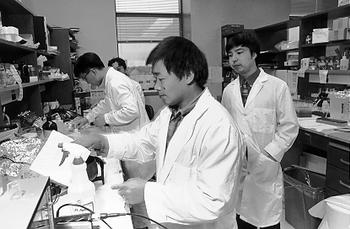Researcher focuses on cellular-level cancer clues

Peng Liang, Ph.D. (right) looks on as graduate student Hakryrul Jo (left) and research assistant Hong Zhang study gene functions. Photo by Donna Jone Bailey.
A Vanderbilt Cancer Center scientist, using a method he co-invented to identify gene expression, is zeroing in on genes regulated by two of the cellular "master switches" involved in tumor development.
Peng Liang, Ph.D., assistant professor of Cell Biology, and his colleagues are studying the oncogene RAS and the tumor suppressor gene p53, which are mutated in a wide number of cancers.
"We are very excited because, for the first time, we can systematically find most of the genes that are regulated by these two master switches," Liang said. "Our goal is to understand their biological functions and to work on their promoters so we can understand what transcription factors are activated in between.
"Many people at Vanderbilt are studying growth factors and working from the outside of the cell inward. We are starting from the other end, finding the genes inside the cell that are being controlled. We hope to meet our colleagues in the middle."
Liang's work uses a rapid and effective method called differential display that enables scientists to identify and study the small fraction of genes that cause one cell to be different from another.
Liang and his mentor, Dr. Arthur Pardee of Harvard Medical School, co-invented the technique in 1992 when Liang was a post-doctoral fellow at Harvard. That year, they published a paper about the approach in Science, and they patented the methodology the following year. In the years since, differential display has become the overwhelmingly favored methodology to clone differentially expressed genes.
The growth and development of humans and other organisms are the result of an intricate balance of genes being turned on and off. Human cells each contain roughly 100,000 genes, but only about 15 percent are active at any given time in any particular cell.
And only a fraction of those are relevant to what makes one cell different from another.
The beauty of differential display is that it enables researchers to compare virtually all the active genes in different cells.
"You can compare old cells to young cells, diseased cells to normal cells, cancerous cells to normal cells," Liang said.
Differential display begins with messenger RNA, working copies of active genes that direct protein synthesis. The mRNA is then copied as DNA, which is more easily manipulated, and then amplified using polymerase chain reaction. Special primers are used in the process that recognize only certain subsets of genes. Using a series of different primers, Liang says, the method can identify a majority of the genes that are active in any given cell.
The amplified cDNAs are spread across a sequencing gel, allowing a side-by-side comparison between cells.
To increase the output and precision of differential display, much of the repetitive pipette work is now handled by a finely programmed robot that has been set up in Liang's lab.
The cancer research model Liang and his colleagues are working with uses a combination of abnormal RAS and p53 genes to transform normal cells into tumor cells. These two genes work together in the development of cancer, much like the ignition, gas pedal and brake all work together to enable a driver to operate a car properly.
The RAS switch inside the cell is activated and inactivated by growth factors and repressors outside the cell. When the RAS gene is abnormal, it's as if the switch is perpetually on and the gas pedal is pushed to the floor, Liang said. If the cell's p53 gene is mutated, then it's like a car with bad brakes; the cell's growth runs out of control.
In their model, Liang and his colleagues take animal cells with a mutated p53 gene and then insert the mutated RAS oncogene and an inducer, ITPG, which turns on the switch.
"We then can watch the normal cells become cancer cells," Liang said. "The transformation takes about 24 hours. We want to look at the genes that are turned on very early in the transformation, so we begin doing differential display as soon as we add the inducer."
With differential display done at four-hour intervals, the research team can see which genes are turned on and off during the transformation. They then clone the identified genes and use Northern blot to confirm the expression of those genes and its correspondence to the expression of the RAS gene.
Three specific genes that the team has identified thus far are called MOB-5, MOB-12 and NCop. MOB-12 and NCop were cloned by graduate student Hakryul Jo during his rotation in Liang's lab.
"We found that the expression of these genes at four hours corresponded beautifully to the expression of the RAS gene," Liang said. "This is very exciting because the whole life process is an intricate control of gene regulation. With differential display, we can see the genes that come on, the genes that go off, as the cell transforms into cancer. Our goal is to identify most of these genes that are pieces of the cancer puzzle, and to understand their biological functions and regulations.
Liang's work is catching the eye of scientific colleagues throughout the world. The National Institutes of Health is now funding his lab's work with the MOB-5 gene, and Liang recently received an innovative technology award from the Society of Chinese Bioscientists in America.













